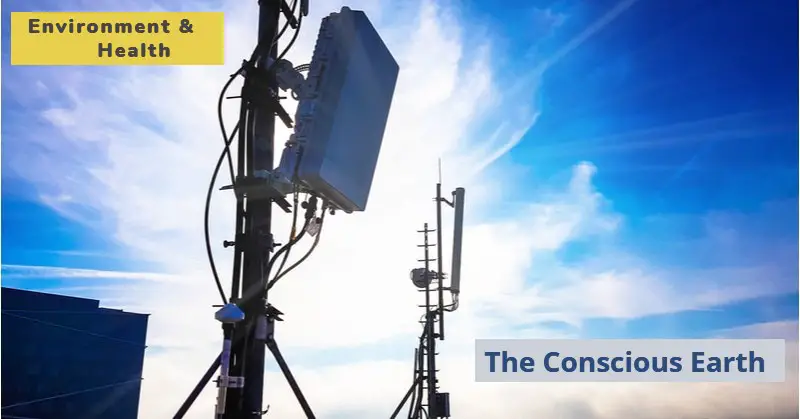
5G (which is short for 5th generation cellular mobile communications technology) is the subject of much controversy. A team from Oregon State University (OSU) has published a paper with their findings on 5G safety as tested with zebrafish. For readers who don’t know, zebrafish (Danio rerio) are a favorite proxy for humans in toxicology and environmental health research.
According to an NIH research program website, 70% of human genes are found in zebrafish and like us, the little fish from the minnow family have “two eyes, a mouth, brain, spinal cord, intestine, pancreas, liver, bile ducts, kidney, esophagus, heart, ear, nose, muscle, blood, bone, cartilage, and teeth. Many of the genes and critical pathways that are required to grow these features are highly conserved between humans and zebrafish. Thus, any type of disease that causes changes in these body parts in humans could theoretically be modeled in zebrafish.” 1

Also, “they require much less space and are cheaper to maintain than mice” and they “breed readily (approximately every 10 days).”1
According to an OSU press release,2 “Findings from an Oregon State University study3 into the effects of radiofrequency radiation generated by the wireless technology that will soon be the standard for cell phones suggest few health impacts.
“Fifth generation or 5G wireless technology, which began being deployed worldwide in 2019, provides faster connectivity and more bandwidth, meaning higher download speeds. But because 5G technology is so new, little is known about the potential health effects from its radiofrequency radiation, which is higher than the current industry standard 4G. The Oregon State study begins to change that.2
“Based on our study, we don’t think 5G radiation is that harmful,” said Subham Dasgupta, a postdoctoral fellow working in the lab of Robyn Tanguay at Oregon State. “It’s predominately benign.”2

“The researchers exposed embryonic zebrafish for two days to 3.5 GHz radiofrequency radiation, the frequency typically used by 5G-enabled cell phones. They found no significant impacts on mortality, how the embryos formed or the embryos’ behavioral response to light. They did find a modest impact on a test that measures the embryos’ response to a sudden sound that they will investigate further.” 2
Next, the research team plans to do research on the effects of 5G radiation on zebrafish at the gene level, examining embryos from the fish used in this first study as they develop into adults. The press release states, that “The researchers also would like to study the impacts of higher frequencies and higher exposure levels on zebrafish to keep pace with the changing cell phone industry.” 2
The paper was published in PLOS ONE and can be read here. 3
In explaining why people have concerns about the safety of 5G technology, the BBC explained, “5G uses higher frequency waves than earlier mobile networks, allowing more devices to have access to the internet at the same time and at faster speeds. These waves travel shorter distances through urban spaces, so 5G networks require more transmitter masts than previous technologies, positioned closer to ground level.” However, the article makes the point that “crucially, because there are more transmitters, each one can run at lower power levels than previous 4G technology, which means that the level of radiation exposure from 5G antennas will be lower.”4
OSU is set to become a leading site for zebrafish research with the recent award of a 5-year, $5.9 million grant from the National Institutes of Environmental Health Sciences to support studies to better understand how environmental exposure to chemicals affects human health. The project will include a “Zebrafish Biomedical Research Core” that “will test the toxicity of chemicals and their impact on human health” as is being done in the 5G study.5
This Oregon State study comes on the heels of a paper published in Toxicology Letters in May 2020 by an international team from Georgia Institute of Technology, McGill University, Albert Einstein College of Medicine and the University of Crete that examined “adverse effects of non-ionizing non-visible radiation reported in the premier biomedical literature.” The paper states that “Many experiments do not include the real-life pulsing and modulation of the carrier signal” and that the authors felt that the “vast majority of experiments do not account for synergistic adverse effects of other toxic stimuli [such as chemical and biological] with wireless radiation.” Based on their review of the literature, the team felt that 5G networking technology “will affect not only the skin and eyes, as commonly believed, but will have adverse systemic effects as well.”6
We will continue to follow this research and bring updates when available.
—R.A. Kroft
Sources:
1NIH Intramural Research Program Blog. Why Use Zebrafish to Study Human Diseases? National Institutes of Health. 9 August 2016.
2Oregon State University. 5G Networks Have Few Health Impacts, Oregon State Study Using Zebrafish Model Finds. News Release. 8 July 2020.
3Dasgupta, S et al. Impacts of high dose 3.5 GHz cellphone radiofrequency on zebrafish embryonic development. PLOS ONE 9 July 2020.
4BBC News. Does 5G Pose Health Risks. BBC News Europe. 15 July 2019.
5Oregon State University. Oregon State Receives $5.9 Million to Study Environmental Health Problems. New Release. 2 July 2020.
6Kostoff RN, Heroux P, Aschner M, Tsatsakis A. Adverse health effects of 5G mobile networking technology under real-life conditions. Toxicology Letters. 2020;323:35-40.
—
R.A. Kroft writes about her day-to-day journey in living a smaller, more sustainable life and other topics that interest her.

This Site Was Inspired By An Interest in Protecting the Environment:
We had the privilege and joy of learning from Dr. Charlie Stine who instilled a love for the natural world through incredible field trips with the Johns Hopkins Odyssey Certificate program in Environmental Studies. At the time, the program was endorsed by the Maryland Department of Natural Resources. Sadly, after Dr. Stine retired, the program was phased out. We hope that we honor his legacy by shining a bright light on environmental issues and sharing good news about the success of various conservation programs when possible.
